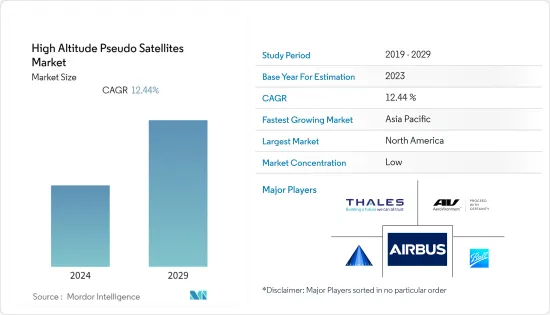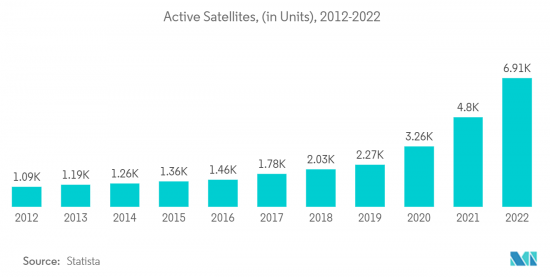 |
市場調査レポート
商品コード
1405344
高高度疑似衛星-市場シェア分析、産業動向・統計、2024~2029年の成長予測High Altitude Pseudo Satellites - Market Share Analysis, Industry Trends & Statistics, Growth Forecasts 2024 - 2029 |
||||||
● お客様のご希望に応じて、既存データの加工や未掲載情報(例:国別セグメント)の追加などの対応が可能です。 詳細はお問い合わせください。
| 高高度疑似衛星-市場シェア分析、産業動向・統計、2024~2029年の成長予測 |
|
出版日: 2024年01月04日
発行: Mordor Intelligence
ページ情報: 英文 110 Pages
納期: 2~3営業日
|
- 全表示
- 概要
- 目次
高高度疑似衛星市場は、2024年には8億5,000万米ドルと評価され、2029年には15億4,000万米ドルに達すると予測され、予測期間中のCAGRは12.44%を記録します。

HAPSは地上通信システムと衛星通信システムの長所を併せ持つ。HAPSは、従来の静止衛星よりもはるかに経済的な価格対性能マージンで音声、ビデオ、ブロードバンド・サービスを効率的に提供することで、衛星の容量と性能の制約を解消します。そのため、大容量のワイヤレスサービス、特に地上ネットワークが限られた遠隔地でのラスト・マイル・デリバリーに対する需要を満たすために、通信サービス・プロバイダーによる採用が増加しています。
HAPSは製造と運用がより経済的であるが、そのようなプラットフォームの耐久性はその有効性を制限します。無人航空機(UAV)のようなHAPSプラットフォームの場合、プラットフォームの耐久性を高めるために電気推進システムが統合されています。その結果、HAPSプラットフォームの耐久性を高めるために、強力なバッテリーシステムと高充電密度のソーラーパネルの開発に向けて多額の研究開発投資が行われ、電気通信事業者や緊急サービス事業者のエンドユーザーによる採用がより現実的なものとなった。
HAPSは地球大気の成層圏で運用され、空気密度は海面と比べて約7%です。そのため、空中システムはいくつかの運用上の課題に直面しています。例えば、発生する揚力は空気密度の直接関数であるため、このようなプラットフォームは、持続的な飛行を達成するために、より大きな翼面積(固定翼UAVの場合)や体積(飛行船や気球の場合)を必要とすることもあります。設計の重量仕様に確実に準拠するために、システム設計者は、重量の最適化を達成するために、比較的高度で軽量な材料を取り入れなければならないです。例えば、GoogleはProject Loonのために様々な材料を実験しています。彼らはルーン成層圏気球プロジェクトに、金属化マイラー、二軸延伸ポリエチレンテレフタレート(BoPET)、柔軟性の高いクロロプレンの組み合わせを使用することを想定しています。同様に、FacebookはAquilaのプロトタイプの製造にT700炭素繊維を使用しました。HAPSモデルの継続的な開発も、予測期間中に軽量材料に向けた研究開発を促進するものと思われます。
高高度疑似衛星(HAPS)市場動向
飛行船セグメントが2023年に最大の市場シェアを占める
飛行船セグメントは、2023年に最大の市場シェアを占めると予想されます。HAPSは、地表から20km上空の成層圏で運用されるため、通信や監視に効果的なツールです。HAPSは、飛行船の柔軟性と衛星の耐久性をミッションに利用します。このようなサービスを提供するために無人気球に頼るには、例えば天候や搭載エネルギー源の制限といった課題があります。飛行船は、より多くのペイロードを吊り上げ、動力を供給する能力があるため、他のプラットフォームよりも好まれています。飛行船は、到達困難な場所を含め、広範囲を迅速かつ効果的にカバーできます。飛行船のその他の利点は、低コスト、柔軟性、配備の容易さです。飛行船は、通信機器、センサー、カメラなどの特殊なペイロードを運ぶためにカスタマイズされます。例えば、2021年8月、Sceye(米国)は飛行船プラットフォームの3回目の飛行試験を3ヶ月で成功させました。飛行船テストの主要目的は、展望外コマンド、姿勢と自動圧力制御、信頼性の高い発射と上昇を確認することだった。Sceye飛行船は6万5,000フィートまで飛行可能で、太陽エネルギーを動力源としています。
同様に2023年3月、タレスはEuroHAPS高高度プラットフォーム・システム・プロジェクトで4,600万米ドルの契約を獲得しました。このプロジェクトは、11カ国からなる欧州コンソーシアム向けに成層圏プラットフォームを設計することを目的としています。タレスは、長時間飛行が可能で大荷重のミッション用飛行船である太陽光発電飛行船ストラトバスを提供します。EuroHAPSの主要パートナーは、CIRA(イタリア)、Elettronica(イタリア)、Leonardo(イタリア)、ONERA(フランス)、CEA(フランス)、INTA(スペイン)、ESG(ドイツ)、TAO(ドイツ)です。

アジア太平洋が予測期間で市場をリード
アジア太平洋の発展途上国では、遠隔地での通信サービスを確保するための重要なインフラがないため、HAPSの採用率が非常に高いです。HAPSプラットフォームは、捜索救助(SAR)任務、災害救助、環境モニタリング、精密農業に役立っています。インドなどアジア太平洋のいくつかの政府は、HAPSの事前導入試験を許可し、そのようなシステムの実現可能性を批判的に分析しています。HAPSはまた、費用対効果の高いブロードバンド・サービスを効率的に提供し、固定またはモバイル・ユーザーにブロードバンド・アクセスを長期的に提供するための適切な代替インフラとして実行可能です。例えば、成層圏気球は約3~5年の長期間、目的地上空に滞空し、約500km2のエリアをカバーすることができます。例えば、2023年3月には、国立航空宇宙研究所(NAL)がインド初の高高度プラットフォーム(HAP)を打ち上げました。高高度プラットフォームは、特に無線アクセスや緊急通信などの通信分野で多くの用途があります。このデバイスは、治安当局が国境を厳重に警戒し、侵入や密輸を防ぐのにも役立ちます。また、地方行政は、このデバイスを使用して汚染をチェックし、地域の開発活動を把握することができます。科学機関は、HAPの本格的なバージョンは3年程度で完成すると発表しました。
同様に、2022年1月、Sky Perfect JSA、NTT、DOCOMO、Airbusは、宇宙ベースの無線接続エコシステムの一部として、HAPSベースの接続サービスを研究・探求するために提携しました。NTTとSKY Perfect JSATは宇宙ICTインフラプロジェクトでも提携し、宇宙統合コンピューティングネットワークを開発しました。このように、市場参入企業の研究開発努力は、アジア各国の良好な導入動向と相まって、予測期間中にアジア太平洋におけるHAPSの導入を促進すると予想されます。
高高度疑似衛星(HAPS)産業概要
高高度擬似衛星市場は適度に統合され、競争が激しく、各社が最大の市場シェアを獲得しようと競い合っています。スペクトラム管理の課題、HAPSの耐久性の限界、進行中のプロジェクトの中止が市場の成長を妨げると予想されています。市場参入企業は、自社製造能力、世界の拠点網、製品提供、研究開発投資、強力な顧客基盤に基づいて競争しています。AeroVironment, Inc.、Airbus SE、Ball Corporation、Prismatic(BAE Systems plc)、THALESが5大市場参入企業です。各社は、価格帯における技術提供と統合能力に基づいて競争しています。高高度プラットフォームの調達率が上昇することで、予測期間中の市場成長が促進されると予想されるため、新製品を発売するには絶好のタイミングとなります。新規参入業者の脅威は緩やかであるため、製品/サービスの拡大や技術革新の増加により、市場の競合環境はさらに激化するとみられます。例えば、2022年2月、インド国防省(MoD)は、高高度疑似衛星(HAPS)の開発のため、航空宇宙新興企業NewSpaceと契約を締結しました。このイニシアチブは、MoDのInnovations for Defence Excellence(iDEX)プログラムの一環です。インド陸軍の支援を受け、Hindustan Aeronautics Limited(HAL)もプロトタイプ開発のリード・パートナーとして参加します。
その他の特典
- エクセル形式の市場予測(ME)シート
- 3ヶ月間のアナリスト・サポート
目次
第1章 イントロダクション
- 調査の前提条件
- 調査範囲
第2章 調査手法
第3章 エグゼクティブサマリー
第4章 市場力学
- 市場概要
- 市場促進要因
- 市場抑制要因
- 業界の魅力-ポーターのファイブフォース分析
- 供給企業の交渉力
- 買い手/消費者の交渉力
- 新規参入業者の脅威
- 代替品の脅威
- 競争企業間の敵対関係の強さ
第5章 市場セグメンテーション
- 技術分野
- 成層圏気球
- 飛行船
- UAV(無人航空機)
- 地域
- 北米
- 米国
- カナダ
- 欧州
- 英国
- フランス
- ドイツ
- イタリア
- その他の欧州
- アジア太平洋
- 中国
- インド
- 日本
- 韓国
- その他のアジア太平洋
- ラテンアメリカ
- ブラジル
- メキシコ
- 中東・アフリカ
- サウジアラビア
- アラブ首長国連邦
- トルコ
- 南アフリカ
- その他の中東・アフリカ
- 北米
第6章 競合情勢
- ベンダー市場シェア
- 企業プロファイル
- AeroVironment, Inc.
- Airbus SE
- RosAeroSystems
- Prismatic(BAE Systems plc)
- THALES
- Ball Corporation
- Northrop Grumman Corporation
- Hawkeye Systems, Inc.
- Parrot Drone SAS
第7章 市場機会と今後の動向

The High-altitude Pseudo Satellites Market is valued at USD 0.85 billion in 2024 and is anticipated to reach USD 1.54 billion by 2029, registering a CAGR of 12.44% during the forecast period.
HAPS incorporates the best aspects of terrestrial and satellite-based communication systems. They eliminate the capacity and performance limitations of satellites by efficiently delivering voice, video, and broadband services at much more economical pricing vs. performance margins than conventional geostationary satellites. Hence, they are being increasingly adopted by telecommunication service providers to satiate the demand for high-capacity wireless services, especially last-mile delivery in remote areas with limited ground-based network coverage.
Though HAPS are more economical to manufacture and operate, the endurance of such platforms limits their effectiveness. In the case of HAPS platforms, such as unmanned aerial vehicles (UAVs), an electric propulsion system is integrated to enhance the endurance of the platform. It resulted in significant R&D investments towards the development of powerful battery systems and high-charge density solar panels to enhance the endurance of HAPS platforms, thereby making it more feasible for adoption by telecom and emergency service provider end-users.
HAPS operates at the stratospheric layer of the Earth's atmosphere, where the air density is around 7% compared to that at sea level. Hence, airborne systems face several operational challenges. For instance, since the lift generated is a direct function of air density, such platforms may also require a larger wing area (in the case of a fixed-wing UAV) or volume (in the case of an airship or balloon) to achieve sustained flight. To ensure compliance with the design's weight specifications, system designers must incorporate relatively advanced and lightweight materials for achieving weight optimization. For instance, Google is experimenting with a variety of materials for Project Loon. They envisioned using a combination of metalized mylar, Biaxially-oriented polyethylene terephthalate (BoPET), and highly flexible chloroprene for the Loon stratospheric balloon project. Similarly, Facebook used T700 carbon fiber for the construction of the prototype for Aquila. Ongoing development of HAPS models is also envisioned to foster the R&D towards lightweight materials during the forecast period.
High-Altitude Pseudo Satellites (HAPS) Market Trends
Airships Segment to Hold Largest Market Share in 2023
The airship segment is expected to contribute the largest market share in 2023. HAPS are effective tools for communication and surveillance as they operate from the Stratosphere, which is 20 km above the Earth's surface. HAPS uses the flexibility of airships with satellite endurance in missions. There are challenges to relying on unmanned balloons to provide such services, for instance, weather and limited onboard energy sources. Airships are preferred more over other platforms due to their capability to lift and power more payload. Airships can cover large areas quickly and effectively, including hard-to-reach locations. Other benefits of airships are low cost, flexibility, and ease of deployment. Airships are customized to carry specialized payloads such as communication equipment, sensors, and cameras. For instance, in August 2021, Sceye (US) completed a third test of the airship platform flight successfully in three months. The primary objectives of the airship test were to check beyond-line-of-sight command, attitude and automated pressure control, and reliable launch and ascent. Sceye airship can fly to 65,000 ft and is powered by solar energy.
Similarly, in March 2023, Thales received a USD 46 million contract for the EuroHAPS High-Altitude Platform Systems project. The project aims to design a stratospheric platform for a European consortium of eleven countries. Thales will provide the solar-powered airship Stratobus, which is a long-endurance, large-payload mission airship. The primary partners of EuroHAPS are CIRA (Italy), Elettronica (Italy), Leonardo (Italy), ONERA (France), CEA (France), INTA (Spain), ESG (Germany), and TAO(Germany).

Asia-Pacific Region to Lead the Market in the Forecast Period
The adoption of HAPS is significantly high in developing countries in the Asia-Pacific region due to the absence of critical infrastructure to ensure telecommunication services in remote locations. HAPS platforms are instrumental in search and rescue (SAR) missions, disaster relief, environmental monitoring, and precision agriculture. Several governments in Asia-Pacific, such as India, permitted the pre-deployment testing of HAPS to critically analyze the feasibility of such systems in the countries. HAPS also efficiently delivers cost-effective broadband services and is viable as a suitable alternative infrastructure for the long-term provision of broadband access to fixed or mobile users. For instance, stratospheric balloons can stay afloat over their destined region for long periods of about 3-5 years and provide coverage over an area of around 500 km2. For instance, in March 2023, the National Aerospace Laboratories (NAL) launched India's first High Altitude Platform (HAP). High Altitude Platform includes a lot of applications, especially in communication like wireless access and emergency communication. The device can also help security agencies to keep a tight vigil at borders and prevent infiltrations and smuggling. The local administration can also use the device to check pollution and take stock of development activities in the area. The scientific agency informed that the full-fledged version of HAP will be ready in around three years.
Similarly, in January 2022, Sky Perfect JSAT, NTT, DOCOMO, and Airbus partnered to study and explore HAPS-based connectivity services as part of a space-based wireless connectivity ecosystem. NTT and SKY Perfect JSAT also partnered in the outer space ICT infrastructure project and developed a space-integrated computing network. Thus, the R&D efforts of the market players, coupled with favorable adoption trends in different Asian countries, are anticipated to drive the adoption of HAPS in the Asia-Pacific region in the forecast period.
High-Altitude Pseudo Satellites (HAPS) Industry Overview
The high-altitude pseudo-satellites market is moderately consolidated and highly competitive, with players competing to gain the largest market share. Spectrum management challenges, endurance limitations of HAPS, and the cancellation of ongoing projects are envisioned to impede the growth of the market. Market players compete based on their in-house manufacturing capabilities, global footprint network, product offerings, R&D investments, and strong client base. AeroVironment, Inc., Airbus SE, Ball Corporation, Prismatic (BAE Systems plc), and THALES are the five major market players. They compete based on technological offerings and integration capabilities at a given price point. An increase in the high-altitude platform procurement rate is expected to fuel the market growth during the forecast period, thereby making it an ideal time to launch new products. Since the threat of new entrants is moderate, the competitive environment in the market is likely to intensify further due to an increase in product/service extensions and technological innovations. For instance, in February 2022, the Ministry of Defence (MoD) (India) inked a deal with aerospace startup NewSpace for the development of a High-Altitude Pseudo Satellite (HAPS). The initiative is part of the MoD's Innovations for Defence Excellence (iDEX) program. Backed by the Indian Army, the initiative will also see Hindustan Aeronautics Limited (HAL) come on board as the lead prototype development partner.
Additional Benefits:
- The market estimate (ME) sheet in Excel format
- 3 months of analyst support
TABLE OF CONTENTS
1 INTRODUCTION
- 1.1 Study Assumptions
- 1.2 Scope of the Study
2 RESEARCH METHODOLOGY
3 EXECUTIVE SUMMARY
4 MARKET DYNAMICS
- 4.1 Market Overview
- 4.2 Market Drivers
- 4.3 Market Restraints
- 4.4 Industry Attractiveness - Porter's Five Forces Analysis
- 4.4.1 Bargaining Power of Suppliers
- 4.4.2 Bargaining Power of Buyers/Consumers
- 4.4.3 Threat of New Entrants
- 4.4.4 Threat of Substitute Products
- 4.4.5 Intensity of Competitive Rivalry
5 MARKET SEGMENTATION
- 5.1 Technology
- 5.1.1 Stratospheric Balloons
- 5.1.2 Airships
- 5.1.3 UAVs
- 5.2 Geography
- 5.2.1 North America
- 5.2.1.1 United States
- 5.2.1.2 Canada
- 5.2.2 Europe
- 5.2.2.1 United Kingdom
- 5.2.2.2 France
- 5.2.2.3 Germany
- 5.2.2.4 Italy
- 5.2.2.5 Rest of Europe
- 5.2.3 Asia-Pacific
- 5.2.3.1 China
- 5.2.3.2 India
- 5.2.3.3 Japan
- 5.2.3.4 South Korea
- 5.2.3.5 Rest of Asia Pacific
- 5.2.4 Latin America
- 5.2.4.1 Brazil
- 5.2.4.2 Mexico
- 5.2.5 Middle East & Africa
- 5.2.5.1 Saudi Arabia
- 5.2.5.2 United Arab Emirates
- 5.2.5.3 Turkey
- 5.2.5.4 South Africa
- 5.2.5.5 Rest of Middle East & Africa
- 5.2.1 North America
6 COMPETITIVE LANDSCAPE
- 6.1 Vendor Market Share
- 6.2 Company Profiles
- 6.2.1 AeroVironment, Inc.
- 6.2.2 Airbus SE
- 6.2.3 RosAeroSystems
- 6.2.4 Prismatic (BAE Systems plc)
- 6.2.5 THALES
- 6.2.6 Ball Corporation
- 6.2.7 Northrop Grumman Corporation
- 6.2.8 Hawkeye Systems, Inc.
- 6.2.9 Parrot Drone SAS
